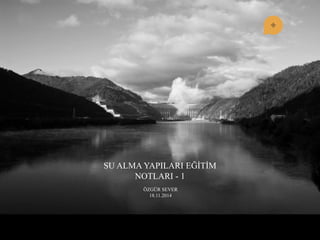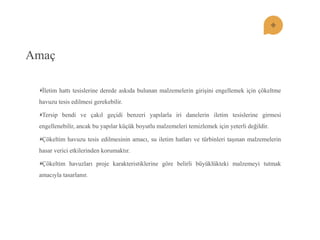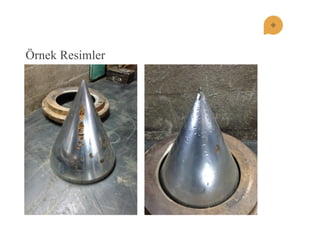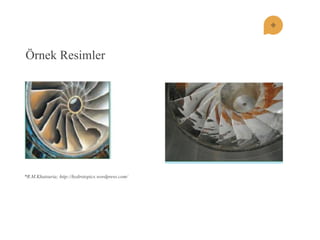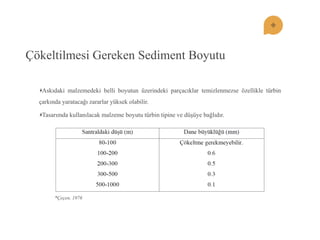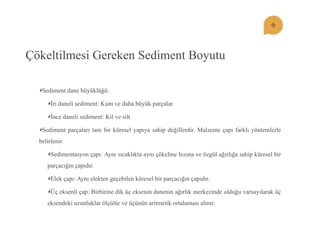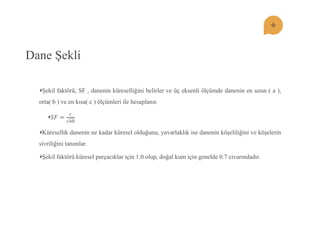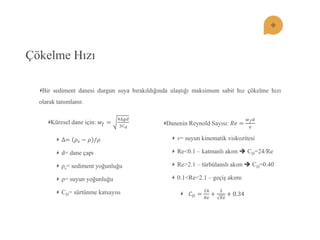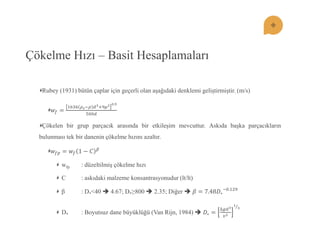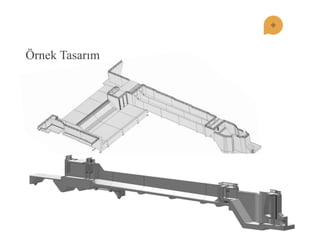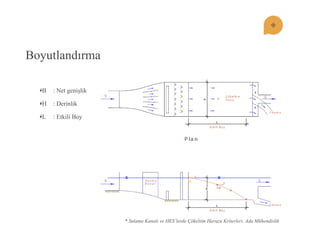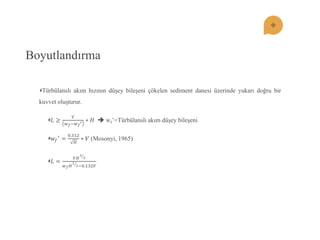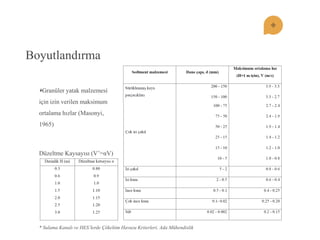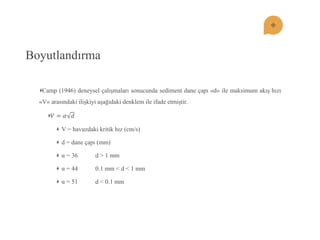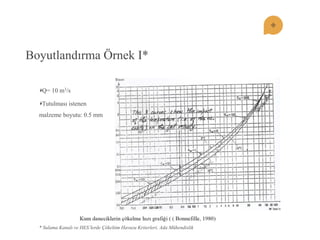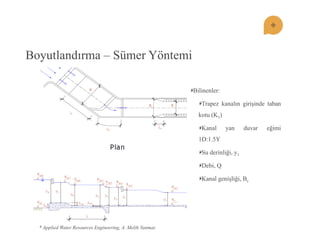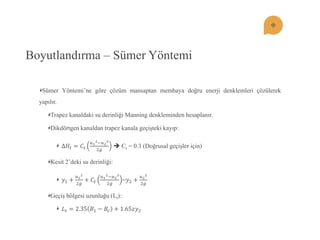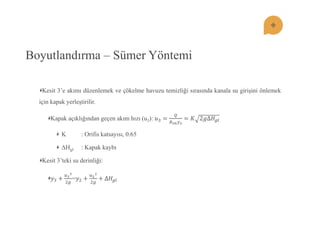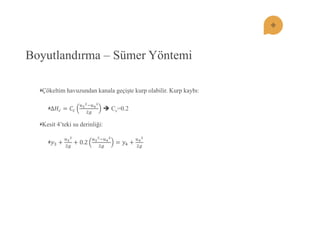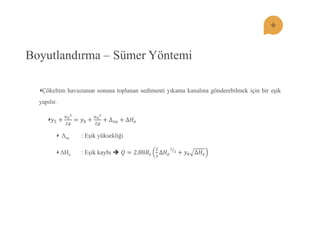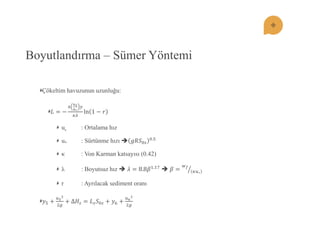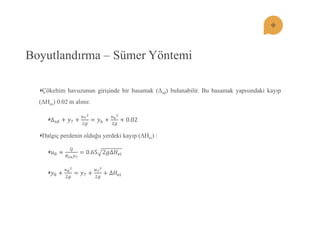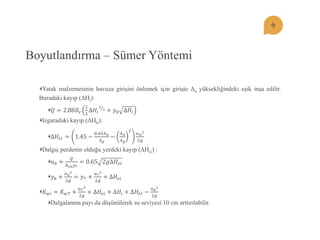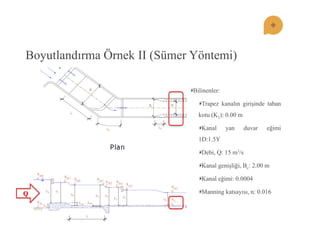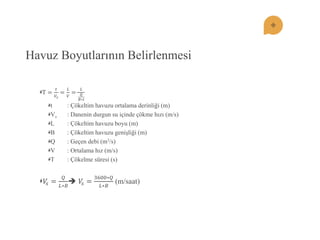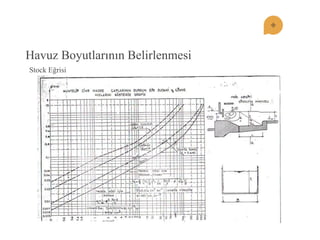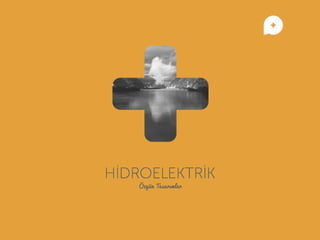Su Alma YapÄąlarÄą EÄitim NotlarÄą - 1
- 1. SU ALMA YAPILARI EÄÄ TÄ M NOTLARI - 1 ÃZGÃR SEVER 18.11.2014
- 2. Genel Bilgi Hidroelektrik santrallerde enerji Þretimi için gerekli olan akÄąmÄąn, akarsudan çevrilip dÞzgÞn bir ÄĒekilde diÄer yapÄąlara iletilmesini saÄlayan yapÄąlara ÂŦSu Alma YapÄąlarÄąÂŧ denmektedir. Su alma yapÄąlarÄą, suyu çevireceÄi kaynaÄa ve suyu ileteceÄi yapÄąya gÃķre tasarlanmalÄądÄąr. Su alma yapÄąlarÄąnÄąn ortak Ãķzellikleri: Su alma yapÄąsÄą baÄlandÄąÄÄą iletim yapÄąsÄąna suyu kontrollÞ olarak verebilmelidir. Ãevrilen akÄąmÄą sedimentten ve yÞzer malzemeden arÄąndÄąracak ÄĒekilde tasarlanmalÄądÄąr.
- 3. Amaç Ä letim hattÄą tesislerine derede askÄąda bulunan malzemelerin giriÄĒini engellemek için çÃķkeltme havuzu tesis edilmesi gerekebilir. Tersip bendi ve çakÄąl geçidi benzeri yapÄąlarla iri danelerin iletim tesislerine girmesi engellenebilir, ancak bu yapÄąlar kÞçÞk boyutlu malzemeleri temizlemek için yeterli deÄildir. ÃÃķkeltim havuzu tesis edilmesinin amacÄą, su iletim hatlarÄą ve tÞrbinleri taÄĒÄąnan malzemelerin hasar verici etkilerinden korumaktÄąr. ÃÃķkeltim havuzlarÄą proje karakteristiklerine gÃķre belirli bÞyÞklÞkteki malzemeyi tutmak amacÄąyla tasarlanÄąr.
- 5. Ãrnek Resimler *R.M.Khatsuria; http://hydrotopics.wordpress.com/
- 6. ÃÃķkeltilmesi Gereken Sediment Boyutu AskÄądaki malzemedeki belli boyutun Þzerindeki parçacÄąklar temizlenmezse Ãķzellikle tÞrbin çarkÄąnda yaratacaÄÄą zararlar yÞksek olabilir. TasarÄąmda kullanÄąlacak malzeme boyutu tÞrbin tipine ve dÞÄĒÞye baÄlÄądÄąr. *Ãeçen, 1976
- 7. ÃÃķkeltilmesi Gereken Sediment Boyutu Sediment dane bÞyÞklÞÄÞ: Ä ri daneli sediment: Kum ve daha bÞyÞk parçalar Ä nce daneli sediment: Kil ve silt Sediment parçalarÄą tam bir kÞresel yapÄąya sahip deÄillerdir. Malzeme çapÄą farklÄą yÃķntemlerle belirlenir. Sedimentasyon çapÄą: AynÄą sÄącaklÄąkta aynÄą çÃķkelme hÄązÄąna ve ÃķzgÞl aÄÄąrlÄąÄa sahip kÞresel bir parçacÄąÄÄąn çapÄądÄąr. Elek çapÄą: AynÄą elekten geçebilen kÞresel bir parçacÄąÄÄąn çapÄądÄąr. Ãç eksenli çap: Birbirine dik Þç eksenin danenin aÄÄąrlÄąk merkezinde olduÄu varsayÄąlarak Þç eksendeki uzunluklar ÃķlçÞlÞr ve ÞçÞnÞn aritmetik ortalamasÄą alÄąnÄąr.
- 8. Dane ÄĄekli ÄĄekil faktÃķrÞ, SF , danenin kÞreselliÄini belirler ve Þç eksenli ÃķlçÞmde danenin en uzun ( a ), orta( b ) ve en kÄąsa( c ) ÃķlçÞmleri ile hesaplanÄąr. ííđ= í íí KÞresellik danenin ne kadar kÞresel olduÄunu, yuvarlaklÄąk ise danenin kÃķÄĒeliliÄini ve kÃķÄĒelerin sivriliÄini tanÄąmlar. ÄĄekil faktÃķrÞ kÞresel parçacÄąklar için 1.0 olup, doÄal kum için genelde 0.7 civarÄąndadÄąr.
- 9. ÃÃķkelme HÄązÄą Bir sediment danesi durgun suya bÄąrakÄąldÄąÄÄąnda ulaÄĒtÄąÄÄą maksimum sabit hÄąz çÃķkelme hÄązÄą olarak tanÄąmlanÄąr. KÞresel dane için: íĪí= 4Îíí 3íķí Î=íí âí/í d= dane çapÄą Ïs= sediment yoÄunluÄu Ï= suyun yoÄunluÄu CD= sÞrtÞnme katsayÄąsÄą Danenin Reynold SayÄąsÄą: í í= íĪíí íĢ v= suyun kinematik viskozitesi Re<0.1 â katmanlÄą akÄąm ïĻ CD=24/Re Re>2.1 â tÞrbÞlanslÄą akÄąm ïĻ CD=0.40 0.1<Re<2.1 â geçiÄĒ akÄąmÄą íķí·= 24 í í + 3 í í +0.34
- 10. ÃÃķkelme HÄązÄą â Basit HesaplamalarÄą 20 šC sÄącaklÄąktaki suda kuartz kumunun çÃķkelme hÄązÄą (Breusers ve Raudkivi, 1991) aÄĒaÄÄądaki denklemlerle hesaplanabilir. (mm/s) íĪí=663í2 ïĻ d < 0.15 mm íĪí=134.5í ïĻ d > 1.50 mm 0.15mm < d < 1.50 mm * Sulama KanalÄą ve HESâlerde ÃÃķkeltim Havuzu Kriterleri, Ada MÞhendislik
- 11. ÃÃķkelme HÄązÄą â Basit HesaplamalarÄą Rubey (1931) bÞtÞn çaplar için geçerli olan aÄĒaÄÄądaki denklemi geliÄĒtirmiÄĒtir. (m/s) íĪí= 1636íí ;íí3:9í20.5500í ÃÃķkelen bir grup parçacÄąk arasÄąnda bir etkileÄĒim mevcuttur. AskÄąda baÄĒka parçacÄąklarÄąn bulunmasÄą tek bir danenin çÃķkelme hÄązÄąnÄą azaltÄąr. íĪíí=íĪí1âíķí― wfp : dÞzeltilmiÄĒ çÃķkelme hÄązÄą C : askÄądaki malzeme konsantrasyonudur (lt/lt) Îē : D*<40 ïĻ 4.67; D*âĨ800 ïĻ 2.35; DiÄer ïĻ í―=7.48í·â ;0.129 D* : Boyutsuz dane bÞyÞklÞÄÞ (Van Rijn, 1984) ïĻ í·â= Îíí3 íĢ213
- 12. ÃzgÞl AÄÄąrlÄąk íū= íííĒííĒ í Îģ : Kuru ÃķzgÞl aÄÄąrlÄąk Wkuru : Kuru aÄÄąrlÄąk V : Hacim * Sulama KanalÄą ve HESâlerde ÃÃķkeltim Havuzu Kriterleri, Ada MÞhendislik
- 13. Ãrnek TasarÄąm
- 14. BoyutlandÄąrma B : Net geniÄĒlik H : Derinlik L : Etkili Boy * Sulama KanalÄą ve HESâlerde ÃÃķkeltim Havuzu Kriterleri, Ada MÞhendislik
- 15. BoyutlandÄąrma í=íâíĩâíŧ Sediment danesinin yatay hÄązÄą akÄąmÄąn hÄązÄąna eÄĒit kabul edilir. Sediment danesi dÞÄĒeyde kendi aÄÄąrlÄąÄÄąnÄąn etkisi ile hareket eder. íĨ=ííĄ; íĶ=íĪííĄ ïĻ íĨ= íĶâí íĪí DolayÄąsÄąyla; íŋâĨ í íĪí âíŧ
- 16. BoyutlandÄąrma TÞrbÞlanslÄą akÄąm hÄązÄąnÄąn dÞÄĒey bileÄĒeni çÃķkelen sediment danesi Þzerinde yukarÄą doÄru bir kuvvet oluÄĒturur. íŋâĨ í íĪí;íĪí âēâíŧ ïĻ wfâ=TÞrbÞlanslÄą akÄąm dÞÄĒey bileÄĒeni íĪí âē= 0.312 íŧ âí (Mosonyi, 1965) íŋ= ííŧ 32 íĪííŧ 12 ;0.132í
- 17. BoyutlandÄąrma GranÞler yatak malzemesi için izin verilen maksimum ortalama hÄązlar (Masonyi, 1965) DÞzeltme KaysayÄąsÄą (Vâ=ÎąV) * Sulama KanalÄą ve HESâlerde ÃÃķkeltim Havuzu Kriterleri, Ada MÞhendislik
- 18. BoyutlandÄąrma Camp (1946) deneysel çalÄąÄĒmalarÄą sonucunda sediment dane çapÄą ÂŦdÂŧ ile maksimum akÄąÄĒ hÄązÄą ÂŦVÂŧ arasÄąndaki iliÄĒkiyi aÄĒaÄÄądaki denklem ile ifade etmiÄĒtir. í=íží V = havuzdaki kritik hÄąz (cm/s) d = dane çapÄą (mm) Îą = 36 d > 1 mm Îą = 44 0.1 mm < d < 1 mm Îą = 51 d < 0.1 mm
- 19. BoyutlandÄąrma Ãrnek I* Q= 10 m3/s TutulmasÄą istenen malzeme boyutu: 0.5 mm * Sulama KanalÄą ve HESâlerde ÃÃķkeltim Havuzu Kriterleri, Ada MÞhendislik
- 20. BoyutlandÄąrma â SÞmer YÃķntemi Bilinenler: Trapez kanalÄąn giriÄĒinde taban kotu (K1) Kanal yan duvar eÄimi 1D:1.5Y Su derinliÄi, y1 Debi, Q Kanal geniÄĒliÄi, Bc * Applied Water Resources Engineering, A. Melih Yanmaz
- 21. BoyutlandÄąrma â SÞmer YÃķntemi SÞmer YÃķntemiâne gÃķre çÃķzÞm mansaptan membaya doÄru enerji denklemleri çÃķzÞlerek yapÄąlÄąr. Trapez kanaldaki su derinliÄi Manning denkleminden hesaplanÄąr. DikdÃķrtgen kanaldan trapez kanala geçiÄĒteki kayÄąp: ÎíŧíĄ=íķíĄ íĒ12;íĒ222í ïĻ Ct = 0.3 (DoÄrusal geçiÄĒler için) Kesit 2âdeki su derinliÄi: íĶ1+ íĒ122í +íķíĄ íĒ12;íĒ222í =íĶ2+ íĒ222í GeçiÄĒ bÃķlgesi uzunluÄu (Lt): íŋíĄ=2.35íĩ1âíĩí+1.65í§íĶ2
- 22. BoyutlandÄąrma â SÞmer YÃķntemi Kesit 3âe akÄąmÄą dÞzenlemek ve çÃķkelme havuzu temizliÄi sÄąrasÄąnda kanala su giriÄĒini Ãķnlemek için kapak yerleÄĒtirilir. Kapak aÃ§ÄąklÄąÄÄąndan geçen akÄąm hÄązÄą (u3): íĒ3= í íĩ3ííĶ3=íū2íÎíŧíí K : Orifis katsayÄąsÄą, 0.65 ÎHgl : Kapak kaybÄą Kesit 3âteki su derinliÄi: íĶ3+ íĒ322í =íĶ2+ íĒ222í +Îíŧíí
- 23. BoyutlandÄąrma â SÞmer YÃķntemi ÃÃķkeltim havuzundan kanala geçiÄĒte kurp olabilir. Kurp kaybÄą: Îíŧí=íķí íĒ32;íĒ422í ïĻ Cc=0.2 Kesit 4âteki su derinliÄi: íĶ3+ íĒ322í +0.2 íĒ32;íĒ422í =íĶ4+ íĒ422í
- 24. BoyutlandÄąrma â SÞmer YÃķntemi ÃÃķkeltim havuzunun sonuna toplanan sedimenti yÄąkama kanalÄąna gÃķnderebilmek için bir eÄĒik yapÄąlÄąr. íĶ5+ íĒ522í =íĶ4+ íĒ422í +Îí íĒ+Îíŧí Îsu : EÄĒik yÞksekliÄi ÎHe : EÄĒik kaybÄą ïĻ í=2.88íĩí 23Îíŧí 32 +íĶ4Îíŧí
- 25. BoyutlandÄąrma â SÞmer YÃķntemi ÃÃķkeltim havuzunun uzunluÄu: íŋ=â 6 íĒí íĒâ íĶ í í ln1âí us : Ortalama hÄąz u* : SÞrtÞnme hÄązÄą ïĻíí í0í 0.5 Κ : Von Karman katsayÄąsÄą (0.42) Îŧ : Boyutsuz hÄąz ïĻ í=8.8í―1.17 ïĻ í―= íĪí í íĒâ r : AyrÄąlacak sediment oranÄą íĶ5+ íĒ522í +Îíŧí =íŋí í0í +íĶ6+ íĒ622í
- 26. BoyutlandÄąrma â SÞmer YÃķntemi ÃÃķkeltim havuzunun giriÄĒinde bir basamak (Îsd) bulunabilir. Bu basamak yapÄąsÄąndaki kayÄąp (ÎHes) 0.02 m alÄąnÄąr. Îí í+íĶ7+ íĒ722í =íĶ6+ íĒ622í +0.02 DalgÄąÃ§ perdenin olduÄu yerdeki kayÄąp (ÎHei) : íĒ8â í íĩí ííĶ7=0.652íÎíŧíí íĶ8+ íĒ822í =íĶ7+ íĒ722í +Îíŧíí
- 27. BoyutlandÄąrma â SÞmer YÃķntemi Yatak malzemesinin havuza giriÄĒini Ãķnlemek için giriÄĒte Îu yÞksekliÄindeki eÄĒik inÄĒa edilir. Buradaki kayÄąp (ÎHi): í=2.88íĩí 23Îíŧí 32 +íĶ8Îíŧí Izgaradaki kayÄąp (ÎHtr): ÎíŧíĄí=1.45â 0.45íīí íīí â íīí íīí 2 íĒí 22í DalgÄąÃ§ perdenin olduÄu yerdeki kayÄąp (ÎHei) : íĒ8â í íĩí ííĶ7=0.652íÎíŧíí íĶ8+ íĒ822í =íĶ7+ íĒ722í +Îíŧíí íūíĪí=íūíĪ7+ íĒ722í +Îíŧíí+Îíŧí+ÎíŧíĄíâ íĒ822í Dalgalanma payÄą da dÞÄĒÞnÞlerek su seviyesi 10 cm arttÄąrÄąlabilir.
- 28. BoyutlandÄąrma Ãrnek II (SÞmer YÃķntemi) Bilinenler: Trapez kanalÄąn giriÄĒinde taban kotu (K1): 0.00 m Kanal yan duvar eÄimi 1D:1.5Y Debi, Q: 15 m3/s Kanal geniÄĒliÄi, Bc: 2.00 m Kanal eÄimi: 0.0004 Manning katsayÄąsÄą, n: 0.016 Q
- 29. Havuz BoyutlarÄąnÄąn Belirlenmesi T= íĄ íí = íŋ í = íŋ í íĩâíĄ t : ÃÃķkeltim havuzu ortalama derinliÄi (m) Vs : Danenin durgun su içinde çÃķkme hÄązÄą (m/s) L : ÃÃķkeltim havuzu boyu (m) B : ÃÃķkeltim havuzu geniÄĒliÄi (m) Q : Geçen debi (m3/s) V : Ortalama hÄąz (m/s) T : ÃÃķkelme sÞresi (s) íí = í íŋâíĩ ïĻ íí = 3600âí íŋâíĩ (m/saat)
- 30. Havuz BoyutlarÄąnÄąn Belirlenmesi Stock EÄrisi

